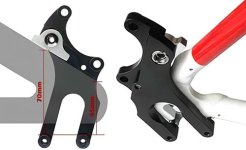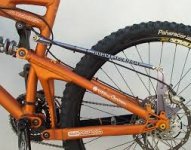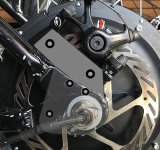rick_p
100 W
There are a lot of ready made conversion kits out there, so if you're building an eBike using a generic mountain bike frame, you may be wasting your time fabricating your own conversion kit for a disc brake setup.
However, in this case, the frame is not generic at all, it started out as an eBike (early Pedego Intercepter) that out-lived its service life, it was ridden until the battery and hub motor were both worn out. I have two of these bikes actually, I bought the second one for parts, my original bike has a battery issue, but the hub motor and controller are good, so I will continue to use the original brake setup on that bike, even after I fix the battery.
As you can see in the picture below, these bikes originally came with some sort of coaster, or drum brake setup in the rear. At a glance it looks like there is a brake disc, but it's not, and to be honest, I'm not sure what purpose that disc serves, there isn't a PAS sensor either, so who knows! The actual brake mechanism is inside the housing in front of the disc.
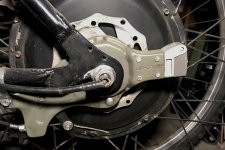
I scored a good deal on a hub motor wheel, controller, and throttle, so I decided to rebuild the parts bike. As you can see below, the new wheel is made for a disc brake setup, but the frame is not, and due to the abnormal width of the frame, which has extra distance between dropouts to make room for the original drum brake, a ready made conversion bracket is not ideal here without additional fabrication of some kind, but if I'm going to start fabricating, I might as well make my own bracket, right!
Below is a side view with the new wheel installed with the caliper temporarily clamped onto the rotor. The bike is upside down, sorry if that makes it hard to see what's going on, but from this angle it appears like a ready made bracket would work, but the next picture shows why that is not necessarily true.
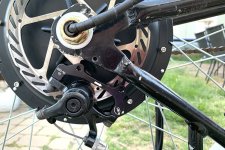
In order to take up the extra distance between the dropouts and to keep the wheel centered in the frame, I have the torque washers and one extra 1/8" washer on the inside of the frame on each side of the wheel, but note that on the caliper side I could move the torque washer to the outside and use 1/8" stock to build the bracket out of, which happens to create the perfect amount of inset for the bracket to match up with the mounting holes of the caliper bracket.
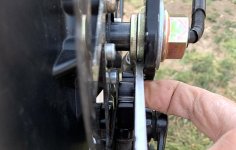
This is as far as I've gotten so far, stay tuned.
However, in this case, the frame is not generic at all, it started out as an eBike (early Pedego Intercepter) that out-lived its service life, it was ridden until the battery and hub motor were both worn out. I have two of these bikes actually, I bought the second one for parts, my original bike has a battery issue, but the hub motor and controller are good, so I will continue to use the original brake setup on that bike, even after I fix the battery.
As you can see in the picture below, these bikes originally came with some sort of coaster, or drum brake setup in the rear. At a glance it looks like there is a brake disc, but it's not, and to be honest, I'm not sure what purpose that disc serves, there isn't a PAS sensor either, so who knows! The actual brake mechanism is inside the housing in front of the disc.

I scored a good deal on a hub motor wheel, controller, and throttle, so I decided to rebuild the parts bike. As you can see below, the new wheel is made for a disc brake setup, but the frame is not, and due to the abnormal width of the frame, which has extra distance between dropouts to make room for the original drum brake, a ready made conversion bracket is not ideal here without additional fabrication of some kind, but if I'm going to start fabricating, I might as well make my own bracket, right!
Below is a side view with the new wheel installed with the caliper temporarily clamped onto the rotor. The bike is upside down, sorry if that makes it hard to see what's going on, but from this angle it appears like a ready made bracket would work, but the next picture shows why that is not necessarily true.

In order to take up the extra distance between the dropouts and to keep the wheel centered in the frame, I have the torque washers and one extra 1/8" washer on the inside of the frame on each side of the wheel, but note that on the caliper side I could move the torque washer to the outside and use 1/8" stock to build the bracket out of, which happens to create the perfect amount of inset for the bracket to match up with the mounting holes of the caliper bracket.

This is as far as I've gotten so far, stay tuned.


